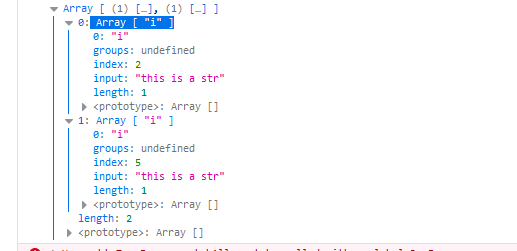Appearance
String.matchAll(新的API)
获取正则表达式匹配的结果组的迭代器对象
主要区别于String.prototype.match()
String.prototype.match()
- 只要有一个reject那么就立即结束
String.prototype.matchAll()
- 只能作用域
//g - 返回的是一个Iterator迭代器
- 返回的结果永远是一个 结果组
语法
js
str.matchAll(regexp)参数
- regexp
正则表达式对象。如果所传参数不是一个正则表达式对象,则会隐式地使用 new RegExp(obj) 将其转换为一个 RegExp 。
RegExp必须是设置了全局模式g的形式,否则会抛出异常TypeError。
返回值
一个迭代器(不可重用,结果耗尽需要再次调用方法,获取一个新的迭代器)。
栗子
js
const str = "this is a str"
const ireg = /i/
const greg = /i/g
// 一个伪数组 {
// 0: "i"
// groups: undefined
// index: 2
// input: "this is a str"
// length: 1
// }
console.log(str.match(ireg)) // [ "i" ]
// 不是一组包含附加特性的结果数组,而是简简单单的数组
console.log(str.match(greg)) // [ "i" , "i" ]
// RegExp String Iterator {} 迭代器
console.log(str.matchAll(greg))
// [[ "i" ] ,[ "i" ] ] ,详情见下图
console.log([...str.matchAll(greg)])
// 报错 Uncaught TypeError: matchAll must be called with a global RegExp
console.log([...str.matchAll(ireg)])
结果:
可见String.prototype.matchAll()的主要作用是解决String.prototype.match()在匹配全局属性的时候,对于多个值的结果只返回匹配的内容,而没有匹配值的附加特性的问题。
